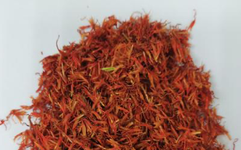Author: Associate Chief Herbalist Zhong Cheng, Second Affiliated Hospital of Guangzhou Medical University
Traditional Chinese Medicine (TCM) has a wide range of herbal sources, with various types and names. Sometimes, a slight difference in name can lead to significant misunderstandings. Recently, while dispensing herbs in the outpatient pharmacy, a patient inquired about the effects of Hong Hua (Safflower) and remarked on the low price of the safflower in the pharmacy compared to the high price of Xi Hong Hua (Saffron). In fact, these two are not the same substance, and thus their prices and effects differ.
Differences
Different Sources and Parts Used
Hong Hua, also known as Chuan Hong Hua, is derived from the flower of the Carthamus tinctorius (Safflower) without the ovary, primarily produced in Henan, Xinjiang, and Sichuan provinces of China.
Xi Hong Hua is the dried stigma of the Crocus sativus (Saffron), mainly produced in Spain, Greece, and France. It was introduced to mainland China via Tibet through India, hence it is also known as Tibetan saffron or saffron. Currently, small amounts are cultivated in Zhejiang and Jiangsu provinces.
Different Characteristics
Hong Hua has tubular flowers without ovaries, measuring about 1-2 cm in length, with a surface that is reddish-yellow or red. The tubular part is elongated, with five lobes at the tip, and the lobes are narrow and 5-8 mm long; it has five stamens with yellowish-white anthers forming a tubular structure; the style is long and cylindrical, slightly bifurcated at the top, soft in texture, with a faint fragrance and a slightly bitter taste.
Xi Hong Hua has linear stigmas that are three-branched, about 3 cm long. It is dark red, with the upper part being wider and slightly flattened, and the edges at the top are irregularly serrated. The inner side has a short fissure, and the lower end sometimes retains a small segment of the yellow style. It is light, soft in texture, lacks oily luster, and becomes brittle and easy to break when dried. It has a unique aroma with a slight irritant quality and a slightly bitter taste.
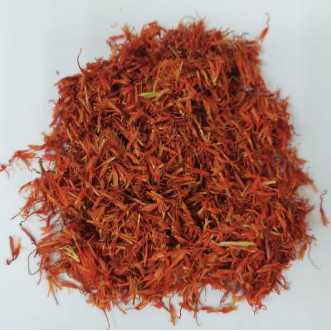
Hong Hua
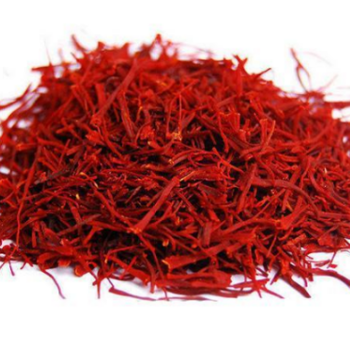
Xi Hong Hua
Different Pharmacological Effects
Hong Hua is warm in nature and pungent in flavor, with effects of invigorating blood circulation, regulating menstruation, dispelling blood stasis, and alleviating pain. It is widely used to treat conditions such as blood stasis leading to amenorrhea, dysmenorrhea, postpartum blood stasis, and traumatic injuries. Modern studies have shown that the decoction of Hong Hua has a stimulating effect on the smooth muscles of the uterus and intestines, so it should be noted that it is contraindicated for pregnant women, and should not be used excessively by those with a tendency to bleed.
Xi Hong Hua has a sweet and slightly cold flavor, with similar effects of invigorating blood circulation and dispelling blood stasis, but it is more potent. It also has the additional effects of cooling the blood, detoxifying, and calming the mind, making it particularly suitable for conditions where heat enters the blood level, causing rashes, and for blood stasis with non-red rashes. Caution should also be taken as it is contraindicated for pregnant women.
Identification
Due to the rarity and high price of Xi Hong Hua, it is often referred to as “plant gold,” while Hong Hua is inexpensive and readily available. Therefore, there are often practices in the market where Hong Hua is used to impersonate or adulterate Xi Hong Hua for profit. Here is a simple identification method—water test:
Hong Hua
When soaked in water, it turns the water golden yellow without fading.
Xi Hong Hua
When soaked in water, it shows an orange-yellow line that gradually spreads, dyeing the water yellow without sediment. The stigma appears trumpet-shaped with a short fissure, and it can be pulled with a needle without breaking, which is the biggest difference from the Hong Hua test.
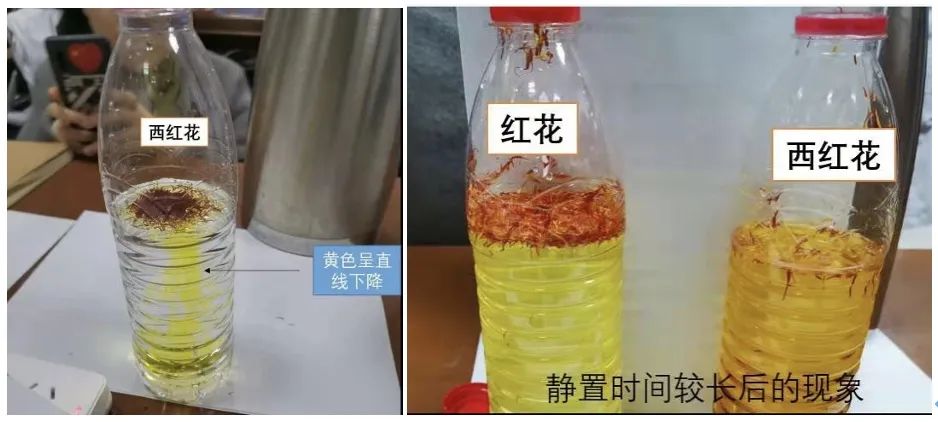
Image source: Grandpa’s Safety Helmet, Yi An Talks Medicine
Prescription Introduction
Invigorating Blood and Dispelling Stasis to Alleviate Pain
10 grams of Hong Hua, 3 slices of fresh ginger, appropriate amount of brown sugar, decocted in water and taken warm. Function: Suitable for menstrual stasis, lower abdominal cold pain, or cold pain in the heart and abdomen with a bluish-purple complexion, cold hands and feet, postpartum abdominal pain due to blood stasis, and traumatic injuries.
Bedsores
500 grams of Hong Hua, decocted and concentrated into a gel-like consistency, applied to gauze and placed on the affected area, secured with disinfected gauze, and changed every other day. Hong Hua can invigorate blood circulation, dispel stasis, dilate blood vessels, and increase local blood circulation, improving skin damage, and has certain effects on bedsores.
Menstrual Irregularities
3 grams of Xi Hong Hua, 100 grams of black beans, 60 grams of brown sugar, decocted in water. It can nourish blood, invigorate blood circulation, regulate menstruation, and alleviate pain.
In clinical applications, due to the rarity and high price of Xi Hong Hua, which is considered a precious medicinal material, it is not commonly used, and pharmacies primarily use Hong Hua.
The images in this article are sourced from the internet for public welfare dissemination. We thank the authors of the images, and if there are any copyright issues, please contact us for removal.

This article was first published by: Second Affiliated Hospital of Guangzhou Medical University
Reviewed by: Guangdong Pharmaceutical Association, Wang Ruolun, Second Affiliated Hospital of Guangzhou Medical University

References
[1] National Pharmacopoeia Commission. Pharmacopoeia of the People’s Republic of China, Volume 1 [S]. Beijing: China Traditional Chinese Medicine Technology Press, 2015.[2] Ma Ju, Chen Xingxing, Liu Jiaming, et al. Atlas of Identification and Application of Chinese Herbal Medicine [M]. Guangzhou: Guangdong Science and Technology Press, 2014.[3] Shi Qi, Xia Xiang, et al. Complete Book of Chinese Dietary Therapy [M]. Shanghai: Shanghai Scientific and Technical Publishers, 1998.[4] Kang Yangguo, Wu Qinan, et al. Chinese Herbal Identification [M]. Beijing: China Traditional Chinese Medicine Press, 2016.
-END-
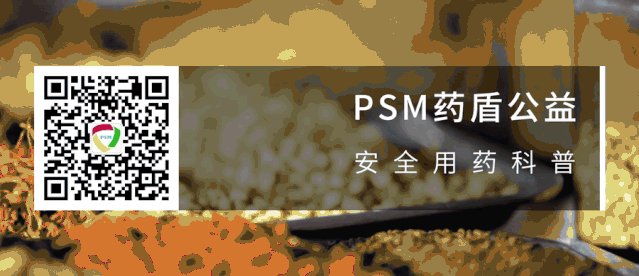


Search for articles related to Hong Hua.

